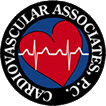Our vascular lab has been accredited for ten years by the Intersocietal Commission for the Accreditation of Vascular Laboratories. The accredited symbol, attached to our reports, indicates that our testing procedures have undergone rigorous review and were found to be accurate and consistent.
Patient Information and Instructions
No special preparations are necessary. You may eat and go about your regular activities, unless you are told otherwise. Wear comfortable clothing (you may wish to wear a two-piece outfit). You may be asked to undress from the waist up or the waist down, depending on the type of exam. (A hospital gown or other type of covering will be provided.)
You will be asked to lie on an exam table. To improve the quality of the ultrasound, a colorless gel is applied to the area where the transducer will be placed. The gel may feel cool and a bit moist, but will be wiped off at the end of the study. During the exam, there may be some minor discomfort from the probe pushing on your chest, neck, or legs, or from the blood pressure cuffs that are used. The exam will take about an hour.
Your study will be interpreted by a physician, and the report sent to your doctor. Should you wish a copy of your interpreted report, we would be happy to provide one to you.
Echocardiogram
An echocardiogram is a test that uses ultrasound waves to examine the heart. It is a safe and painless procedure that helps the doctor diagnose a variety of heart problems. A major benefit of the echo test is that it gives information about the heart’s structure and blood flow without anything entering the body. The test may be used to detect the presence of fluid around the heart, blood clots or masses inside the heart, and abnormal holes between heart chambers. The information gained from the echocardiogram helps your doctor make an accurate diagnosis and develop a treatment plan that is best for you.
Arterial Vascular Testing
The arteries to the legs and arms can also be involved with the same hardening of the arteries that affect the heart or carotid arteries. Arterial vascular testing includes looking at the blood pressure in different segments of the legs and arms, and assessing the pulse waves using ultrasound. In addition, we sometimes produce images of the arteries to identify the location of blockages.
Venous Vascular Testing
Venous ultrasound is used to evaluate and diagnosis vein disease. We can determine the function of the veins including the valves inside the veins to look for venous insufficiency. Ultrasound is also used to look for the presence of clot within the vein, known as deep vein thrombosis. Vein mapping is performed on patients with renal failure to evaluate for placement of permanent access grafts for hemodialysis.
Carotid Artery Testing
The carotid arteries, which are located in the neck, supply the brain. They are frequently involved with atherosclerosis (hardening of the arteries). Commonly, the arteries of the neck are involved with blockages. Sometimes these cholesterol-plaques may dislodge. This may result in a temporary change in mental status associated with changes in speech, loss of strength, or changes in the eyesight (blurred or disturbed vision).


